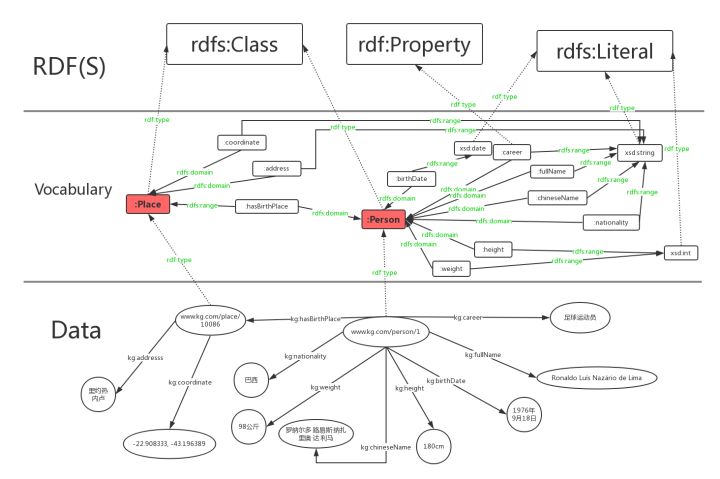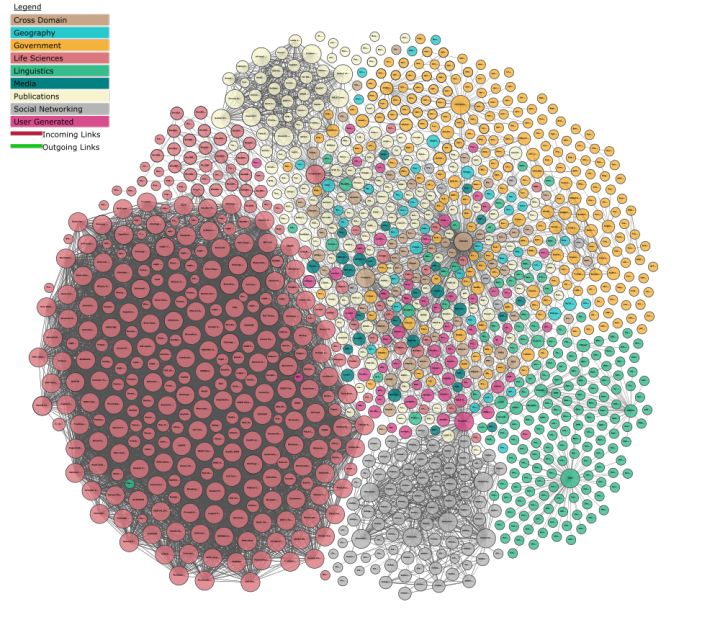1.1. 知识图谱相关-RDF¶
参考-知识图谱-给AI装个大脑 [1]
开放领域知识图谱DBpedia: https://wiki.dbpedia.org/
RDF(Resource Description Framework),即资源描述框架,其本质是一个数据模型(Data Model)。它提供了一个统一的标准,用于描述实体/资源。简单来说,就是表示事物的一种方法和手段。RDF形式上表示为SPO三元组,有时候也称为一条语句(statement),知识图谱中我们也称其为一条知识,如下图。


RDF由节点和边组成,节点表示实体/资源、属性,边则表示了实体和实体之间的关系以及实体和属性的关系。
RDF(Resource Description Framework),即资源描述框架
RDFS,即“Resource Description Framework Schema”,是最基础的模式语言
OWL,即“Web Ontology Language”,语义网技术栈的核心之一
URI(Universal Resource Identifier: 唯一表示某一事物
SPO三元组(Subject-Predicate-Object)
IRIs(International Resource Identifiers
语义网络(Semantic Network)
语义网(Semantic Web)
关联数据(Linked Data)
RDF图:
(主语、宾语是节点、谓语是边的那种)
一共有三种类型,IRIs,blank nodes 和 literals
Subject可以是IRI或blank node。
Predicate是IRI。
Object三种类型都可以。
IRI我们可以看做是URI或者URL的泛化和推广,它在整个网络或者图中唯一定义了一个实体/资源
literal是字面量,我们可以把它看做是带有数据类型的纯文本,如:"周恩来"^^xsd:string
blank node简单来说就是没有IRI和literal的资源,或者说匿名资源
@prefix kg: <http://www.kg.com/ontology/>
kg:chineseName其实就是"http:// www.kg.com/ontology/chineseName"的缩写
1.1.1. RDF序列化方法¶
RDF序列化的方式主要有:RDF/XML,N-Triples,Turtle,RDFa,JSON-LD等几种:
1. RDF/XML,顾名思义,就是用XML的格式来表示RDF数据。
2. N-Triples,即用多个三元组来表示RDF数据集,是最直观的表示方法。
在文件中,每一行表示一个三元组,方便机器解析和处理。开放领域知识图谱DBpedia通常是用这种格式来发布数据的。
3. Turtle, 应该是使用得最多的一种RDF序列化方式了。它比RDF/XML紧凑,且可读性比N-Triples好
4. RDFa, 即“The Resource Description Framework in Attributes”,是HTML5的一个扩展,在不改变任何显示效果的情况下,让网站构建者能够在页面中标记实体,像人物、地点、时间、评论等等。也就是说,将RDF数据嵌入到网页中,搜索引擎能够更好的解析非结构化页面,获取一些有用的结构化信息。读者可以去这个页面感受一下RDFa,其直观展示了普通用户看到的页面,浏览器看到的页面和搜索引擎解析出来的结构化信息。
5. SON-LD,即“JSON for Linking Data”,用键值对的方式来存储RDF数据。
实例

N-Triples:
<http://www.kg.com/person/1> <http://www.kg.com/ontology/chineseName> "罗纳尔多·路易斯·纳萨里奥·德·利马"^^string.
<http://www.kg.com/person/1> <http://www.kg.com/ontology/career> "足球运动员"^^string.
<http://www.kg.com/person/1> <http://www.kg.com/ontology/fullName> "Ronaldo Luís Nazário de Lima"^^string.
<http://www.kg.com/person/1> <http://www.kg.com/ontology/birthDate> "1976-09-18"^^date.
<http://www.kg.com/person/1> <http://www.kg.com/ontology/height> "180"^^int.
<http://www.kg.com/person/1> <http://www.kg.com/ontology/weight> "98"^^int.
<http://www.kg.com/person/1> <http://www.kg.com/ontology/nationality> "巴西"^^string.
<http://www.kg.com/person/1> <http://www.kg.com/ontology/hasBirthPlace> <http://www.kg.com/place/10086>.
<http://www.kg.com/place/10086> <http://www.kg.com/ontology/address> "里约热内卢"^^string.
<http://www.kg.com/place/10086> <http://www.kg.com/ontology/coordinate> "-22.908333, -43.196389"^^string.
用Turtle表示的时候我们会加上前缀(Prefix)对RDF的IRI进行缩写:
@prefix person: <http://www.kg.com/person/> .
@prefix place: <http://www.kg.com/place/> .
@prefix : <http://www.kg.com/ontology/> .
person:1 :chineseName "罗纳尔多·路易斯·纳萨里奥·德·利马"^^string.
person:1 :career "足球运动员"^^string.
person:1 :fullName "Ronaldo Luís Nazário de Lima"^^string.
person:1 :birthDate "1976-09-18"^^date.
person:1 :height "180"^^int.
person:1 :weight "98"^^int.
person:1 :nationality "巴西"^^string.
person:1 :hasBirthPlace place:10086.
place:10086 :address "里约热内卢"^^string.
place:10086 :coordinate "-22.908333, -43.196389"^^string.
同一个实体拥有多个属性(数据属性)或关系(对象属性),我们可以只用一个subject来表示,使其更紧凑。我们可以将上面的Turtle改为:
@prefix person: <http://www.kg.com/person/> .
@prefix place: <http://www.kg.com/place/> .
@prefix : <http://www.kg.com/ontology/> .
person:1 :chineseName "罗纳尔多·路易斯·纳萨里奥·德·利马"^^string;
:career "足球运动员"^^string;
:fullName "Ronaldo Luís Nazário de Lima"^^string;
:birthDate "1976-09-18"^^date;
:height "180"^^int;
:weight "98"^^int;
:nationality "巴西"^^string;
:hasBirthPlace place:10086.
place:10086 :address "里约热内卢"^^string;
:coordinate "-22.908333, -43.196389"^^string.
1.1.2. 轻量级的模式语言——RDFS¶
@prefix rdfs: <http://www.w3.org/2000/01/rdf-schema#> .
@prefix rdf: <http://www.w3.org/1999/02/22-rdf-syntax-ns#> .
@prefix : <http://www.kg.com/ontology/> .
### 这里我们用词汇rdfs:Class定义了“人”和“地点”这两个类。
:Person rdf:type rdfs:Class.
:Place rdf:type rdfs:Class.
### rdfs当中不区分数据属性和对象属性,词汇rdf:Property定义了属性,即RDF的“边”。
:chineseName rdf:type rdf:Property;
rdfs:domain :Person;
rdfs:range xsd:string .
:career rdf:type rdf:Property;
rdfs:domain :Person;
rdfs:range xsd:string .
:fullName rdf:type rdf:Property;
rdfs:domain :Person;
rdfs:range xsd:string .
:birthDate rdf:type rdf:Property;
rdfs:domain :Person;
rdfs:range xsd:date .
:height rdf:type rdf:Property;
rdfs:domain :Person;
rdfs:range xsd:int .
:weight rdf:type rdf:Property;
rdfs:domain :Person;
rdfs:range xsd:int .
:nationality rdf:type rdf:Property;
rdfs:domain :Person;
rdfs:range xsd:string .
:hasBirthPlace rdf:type rdf:Property;
rdfs:domain :Person;
rdfs:range :Place .
:address rdf:type rdf:Property;
rdfs:domain :Place;
rdfs:range xsd:string .
:coordinate rdf:type rdf:Property;
rdfs:domain :Place;
rdfs:range xsd:string .
我们这里只介绍RDFS几个比较重要,常用的词汇:
1. rdfs:Class. 用于定义类。
2. rdfs:domain. 用于表示该属性属于哪个类别
3. rdfs:range. 用于描述该属性的取值类型
4. rdfs:subClassOf. 用于描述该类的父类。比如,我们可以定义一个运动员类,声明该类是人的子类
5. rdfs:subProperty. 用于描述该属性的父属性
比如,我们可以定义一个名称属性,声明中文名称和全名是名称的子类

1.1.3. RDFS的扩展——OWL¶
OWL有两个主要的功能:
1. 提供快速、灵活的数据建模能力
2. 高效的自动推理
实例:
@prefix rdfs: <http://www.w3.org/2000/01/rdf-schema#> .
@prefix rdf: <http://www.w3.org/1999/02/22-rdf-syntax-ns#> .
@prefix : <http://www.kg.com/ontology/> .
@prefix owl: <http://www.w3.org/2002/07/owl#> .
### 这里我们用词汇owl:Class定义了“人”和“地点”这两个类。
:Person rdf:type owl:Class.
:Place rdf:type owl:Class.
### owl区分数据属性和对象属性(对象属性表示实体和实体之间的关系)。词汇owl:DatatypeProperty定义了数据属性,owl:ObjectProperty定义了对象属性。
:chineseName rdf:type owl:DatatypeProperty;
rdfs:domain :Person;
rdfs:range xsd:string .
:career rdf:type owl:DatatypeProperty;
rdfs:domain :Person;
rdfs:range xsd:string .
:fullName rdf:type owl:DatatypeProperty;
rdfs:domain :Person;
rdfs:range xsd:string .
:birthDate rdf:type owl:DatatypeProperty;
rdfs:domain :Person;
rdfs:range xsd:date .
:height rdf:type owl:DatatypeProperty;
rdfs:domain :Person;
rdfs:range xsd:int .
:weight rdf:type owl:DatatypeProperty;
rdfs:domain :Person;
rdfs:range xsd:int .
:nationality rdf:type owl:DatatypeProperty;
rdfs:domain :Person;
rdfs:range xsd:string .
:hasBirthPlace rdf:type owl:ObjectProperty;
rdfs:domain :Person;
rdfs:range :Place .
:address rdf:type owl:DatatypeProperty;
rdfs:domain :Place;
rdfs:range xsd:string .
:coordinate rdf:type owl:DatatypeProperty;
rdfs:domain :Place;
rdfs:range xsd:string .

描述属性特征的词汇:
1. owl:TransitiveProperty. 表示该属性具有传递性质。例如,我们定义“位于”是具有传递性的属性,若A位于B,B位于C,那么A肯定位于C
2. owl:SymmetricProperty. 表示该属性具有对称性。例如,我们定义“认识”是具有对称性的属性,若A认识B,那么B肯定认识A
3. owl:FunctionalProperty. 表示该属性取值的唯一性。 例如,我们定义“母亲”是具有唯一性的属性,若A的母亲是B,在其他地方我们得知A的母亲是C,那么B和C指的是同一个人
4. owl:inverseOf. 定义某个属性的相反关系。例如,定义“父母”的相反关系是“子女”,若A是B的父母,那么B肯定是A的子女。
本体映射词汇(Ontology Mapping):
1. owl:equivalentClass. 表示某个类和另一个类是相同的
2. owl:equivalentProperty. 表示某个属性和另一个属性是相同的
3. owl:sameAs. 表示两个实体是同一个实体
1.1.4. 语义网络¶
优点:
1. 容易理解和展示。
2. 相关概念容易聚类。
缺点:
1. 节点和边的值没有标准,完全是由用户自己定义。
2. 多源数据融合比较困难,因为没有标准。
3. 无法区分概念节点和对象节点。
4. 无法对节点和边的标签(label,我理解是schema层,后面会介绍)进行定义。
简而言之,语义网络可以比较容易地让我们理解语义和语义关系。其表达形式简单直白,符合自然。然而,由于缺少标准,其比较难应用于实践。
RDF的提出解决了语义网络的缺点1和缺点2,在节点和边的取值上做了约束,制定了统一标准,为多源数据的融合提供了便利
RDFS和OWL是RDF更上一层的技术,主要是为了解决语义网络的缺点3和缺点4,其提供了schema层的描述
1.1.5. 语义网(Semantic Web)和链接数据(Linked Data)¶
语义网和链接数据是万维网之父Tim Berners Lee分别在1998年和2006提出的。相对于语义网络,语义网和链接数据倾向于描述万维网中资源、数据之间的关系。
本质上,语义网、链接数据还有Web 3.0都是同一个概念,只是在不同的时间节点和环境中,它们各自描述的角度不同。它们都是指W3C制定的用于描述和关联万维网数据的一系列技术标准,即,语义网技术栈。
链接数据起初是用于定义如何利用语义网技术在网上发布数据,其强调在不同的数据集间创建链接。
链接数据也被当做是语义网技术一个更简洁,简单的描述。当它指语义网技术时,它更强调“Web”,弱化了“Semantic”的部分。对应到语义网技术栈,它倾向于使用RDF和SPARQL(RDF查询语言)技术,对于Schema层的技术,RDFS或者OWL,则很少使用
1.1.6. 知识图谱¶
定义:
A knowledge graph consists of a set of interconnected typed entities and their attributes.

链接数据和知识图谱最大的区别在于:
1. 正如上面Open Linked Data Project所展示的,每一个圆圈代表一个独立存在和维护的知识图谱;链接数据更强调不同RDF数据集(知识图谱)的相互链接。
2. 知识图谱不一定要链接到外部的知识图谱(和企业内部数据通常也不会公开一个道理),更强调有一个本体层来定义实体的类型和实体之间的关系。另外,知识图谱数据质量要求比较高且容易访问,能够提供面向终端用户的信息服务(查询、问答等等)。
实例(The Linked Open Data Cloud): https://lod-cloud.net/





